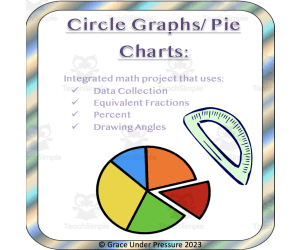2,406 products added recently
Graphing Chart
A Graphing Chart serves as a template or guide for students to create their own graphs. By offering a structured format, students can focus on accurately plotting data and interpreting results. Using graphing charts enhances students' abilities to visually communicate information.
Data, Tables, Graphs and Charts Math Packet
Math, Graphing, Grade 5, Charts, Teacher Tools
Data, Tables, Graphs and Charts Math Packet The Data, Tables, Graphs and Charts Math Packet is an essential tool for progressive 5th-grade educators. This printable packet is ten pages long and available as a PDF file. It is designed to integrate data analysis, tables, graphs, and charts within the math curriculum. Key Learning Concepts Gathering data systematically. Recording results meticulously. Employing diverse types of tables, charts graphs including conversion diagrams for representation. Developing predictive abilities from acquired data. Engaging in informative discussions about findings. Understanding different types of averages: - mean median mode - This packet provides ample flexibility for students to interact with each page effectively. Learners are encouraged to actively analyze varying forms of data across multiple situations. They are prompted to make observations and formulate answers based on their findings. Possible Scenarios for Use Ideal as homework material after teaching sessions . Serves well as review material to reinforce learning concepts . Duplicates could be kept in an Emergency Substitute Kit. Iii could be employed as an assessment tool due to detailed coverage; offering thorough evaluation. Li /ol The versatility of this resource ensures deep engagement with complex ideas presented in easily understandable parts complete with answer keys—making it useable even by self-guided learners. A highly recommended addition that synchs well into any dynamic educator’s toolkit focused on cultivating independent critical thinking skills amongst youngsters today.
Author Elementary Resources 4 U
Tags Data Analysis, Tables, Graphs, Charts, Math
Math Project: Circle Graphs and Pie Charts
Math, Percentages, Geometry, Graphing, Statistics, Grade 4, 5, 6, 7, 8, Charts, Teacher Tools
This fun math project includes clear step-by-step instructions to show your students how to make a circle graph. This is a great way to review several math skills while showing how useful they can be! Tasks include: - Writing a survey question: Your students learn to write a question that has exactly six possible answers. - Collecting data: Your students can ask the members of your class their question. They collect data using a tally chart. They need to ask exactly 25 people. - Recording results as a fraction: Once they have their data, they can turn each answer into a fraction with a denominator of 25. - Calculating an equivalent fraction: Then, they calculate an equivalent fraction with a denominator of 100. - Working with percent (written as a decimal): Finally, they turn that fraction into a percent in decimal form. They use this percent to multiply by 360 degrees in a circle (they can use a calculator for this part) to find out how many degrees each answer gets. - Drawing angles with a protractor: They carefully draw the six angles in their pie chart, one by one. - Labeling a graph: They label the graph to make it clear for others to read. Grades to Use WIth: This math project works well in the middle grades (4-8) when students know how to use protractors, calculate with fractions and decimals, and make graphs. It could also work well in a high school special education classroom. Standards: CCSS7.G.A.2 Draw (freehand, with ruler and protractor, and with technology) geometric shapes with given conditions. Focus on constructing triangles from three measures of angles or sides, noticing when the conditions determine a unique triangle, more than one triangle, or no triangle. CCSS4.NF .C.5 Express a fraction with denominator 10 as an equivalent fraction with denominator 100, and use this technique to add two fractions with respective denominators 10 and 100. For example, express 3/10 as 30/100, and add 3/10 + 4/100 = 34/100. CCSS4.NF .C.6 Use decimal notation for fractions with denominators 10 or 100. For example, rewrite 0.62 as 62/100; describe a length as 0.62 meters; locate 0.62 on a number line diagram.
Author Grace Under Pressure
Tags Math Project, Circile Graphs, Pie Charts, Graphing, Data Collection, Percent, Angles, Protractor, Equivalent Fractions, 7/8 Pie Chart, Circle Graphs Math, Circle Graphs



